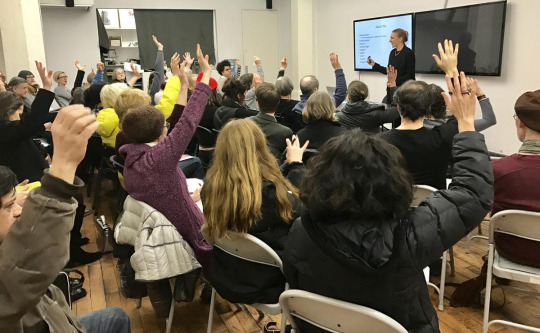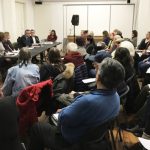Marketing for Artists in the Digital Age – A Talk with Mara Vlatković
On Tuesday, January 17, 2017, marketing and social media wiz Mara Vlatković led a group of enthusiastic artists through an insightful session about the best way to use digital platforms as a marketing tool for artists.
With so much technology readily available at our fingertips, it may be challenging to identify exactly which digital marketing tools work best for you as an artist. If your priority is creating art, how do you find the time to “like,” “post,” and “tag” things?
Worry not! It is possible – read on to find out how:
The Power of Three
Before using any type of digital platform, Mara recommends taking a step back to understand the type of person (or people) you are trying to reach. Answer these three questions:
- Who is your audience? – Who do you currently reach or who do you want to reach?
- Where (online) is your audience? – Think about demographics; what online tools is your audience using?
- What is familiar to you? – What is the easiest tool for you to use; what do you have time for?
“You Do Not Need to be Everywhere”
Once you identify your audience, understand that you do not necessarily need to be connected on multiple digital and social media platforms to successfully market yourself as an artist. Keep in mind that your priority should be your practice, and having accounts that you do not really use may even work against you.
Your Website
Think of your website as your digital central hub. Any social media platforms should always direct your audience back to your website. Because you want the world to know who you are, what you do, and how others can get in touch with you, make sure you have a clear “About Me” section that includes everything you want people to know about you and that is easily found on your site.
Email Marketing
Although existing platforms allow you to easily and quickly engage with your audiences, Mara suggests not disregarding email as an effective tool for staying in touch with them. Using sites like Mailchimp and Constant Contact can make it easy to send emails. Make sure you regularly update your email list with important contacts and remember to add links to your events, performances, and sites where tickets can be purchased.
Social Media
Facebook, Instagram, and Twitter are the three most-used social media platforms in the United States, with 1.79 billion, 600 million, and 317 million users respectively in 2016. Although these are fabulous platforms for spreading the word about your work, make sure you spend some time understanding how each platform functions, and decide whether or not they work for you. For example:
- Facebook is great for reaching large audiences. Content can be easily shared through private or public accounts. However, it can be difficult to manage and must be updated frequently to be effective.
- Instagram is largely image and mobile-focused so it may not be the easiest platform for musicians to discover content, but it can be great for visually heavy artists! The new Stories feature can also be great for performing artists.
- Twitter users have a language of their own and are limited to using 140 characters. Although your Tweets must be short and sweet, they are great for reaching press and many use the platform to stay on top of current events and popular topics.
Create a Digital Marketing Calendar
Now that you have identified your audience and learned about some social media platforms, your goal is to find a way to incorporate them into your daily activities. Mara suggests creating a calendar to schedule frequent posts in order to keep your audience engaged and interested in what you are doing – especially if you are promoting an upcoming event.
Try planning out 3 months before your event and work backwards, starting with behind-the-scenes style posts. People love behind the scenes! If you are not promoting a specific event, still share your practice and updates with your audience. People love to see and hear what you are up to.
When creating content, work with your strengths. If writing is not your strong suit, take pictures or post videos instead. What is important is discovering what works for you. The more time you invest in finding that out, the more likely you are to be active, and the more likely you are to connect and engage with your audience online.
How Will I Know it’s Working?
Once you familiarize yourself with various digital tools and become a frequent and active user, Mara recommends using Analytics to track which sites are successful and find out which of your sites are attracting the most people. Google Analytics and Piwik may be good options. Social media also offers these tools through Buffer, Bitly, Twitter Analytics, Instagram Insights, Hootsuite, and Followerwonk.
Keeping track, and getting rid of the platforms that do not bring people to you, will allow you to be more time-efficient and will give you time to spend on the one thing you love to do – create art.
For more marketing insights, including information about the importance of a marketing plan, read up on Marketing 101: How to Share Your Story on NYFA Current.
Mara Vlatković is a communications professional and arts manager based in New York City. With previous experience in cultural diplomacy and international development in Washington D.C., she has turned her focus on start-ups and organizations that support artists and creatives in fulfilling their full potential. She has a M.A. in Culture, Policy, and Management from City University London and a B.S. in Sociology from the London School of Economics. Mara is the Founder of Young Professionals in the Arts (YPA) and provides training in digital marketing to artists and art professionals. She previously worked at the New York Foundation for the Arts (NYFA) as the Digital Communications Officer.
– Rosario Calatayud Serna, Program Associate, NYFA Learning
This program is part of NYFA Learning, which includes professional development for artists and arts administrators. Sign up for NYFA’s free bi-weekly newsletter to receive updates on future programs.
Image: Marketing for Artists in the Digital Age, Photo Credit: Judy Cai





